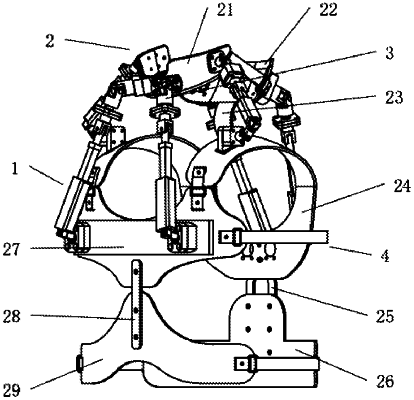|
1. A wearable multifunctional powered exoskeleton for cervical vertebra rehabilitation, comprising an active drive motor module, a fixed supporting module and a movable joint component; the active drive motor module is connected to the fixed supporting module, and comprises a left shoulder push rod motor, a right shoulder push rod motor, a cervico-thoracic vertebra left front side push rod motor, a cervico-thoracic vertebra left rear side push rod motor, a cervico-thoracic vertebra right front side push rod motor, and a cervico-thoracic vertebra right rear side push rod motor; and the active drive motor module and the movable joint component are combined to jointly form a six-connecting rod power-driven structure; wherein the fixed supporting module comprises a lower jaw supporting component, an occipital bone supporting component, a rear side cervical vertebra supporting part, a cervico-thoracic vertebra front side supporting sheet, and a cervico-thoracic vertebra rear side supporting sheet; wherein the movable joint component comprises universal joints and spherical joint rotating hinges; wherein the occipital bone supporting component is in threaded connection with the rear side cervical vertebra supporting part; and when antiflexion and retroextension, lateral flexion and horizontal rotation rehabilitation exercises of the cervical vertebra are performed, the rear side cervical vertebra supporting part is dismantled, and an angle transducer is arranged at a middle position of the occipital bone supporting component.
|
